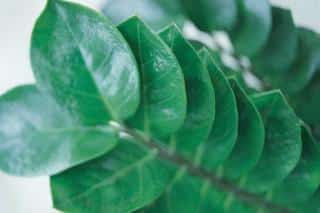

Emerald palm looks like a palm, but it’s not! Always a great houseplant, of course.
Emerald palm facts
Name – Zamioculcas zamiifolia
Family – Araceae
Type – succulent houseplant
Height – 1 ½-3 ft / 0.5-1 m indoors
Exposure – well-lit, indirect
Soil: draining – Foliage: evergreen – Propagation: clump division, cuttings
The botanical name is Zamioculcas zamiifolia. Its lush, green growth and incredible resistance make it a favorite household plant. Grow a lush emerald palm for both home and office with these guidelines.
To make your emerald palm feel right at home, it’s important to repot it right away. Go for a pot that’s one size larger than the one you first got it in (1 inch larger across, or 2-3 cm).
Here are the basic steps to repot your emerald palm:
 Start off with 1 full inch of drainage, even 2 if possible (3 to 5 cm). This can be gravel, clay pebbles, or broken pot shards.
Start off with 1 full inch of drainage, even 2 if possible (3 to 5 cm). This can be gravel, clay pebbles, or broken pot shards.If you’re lucky to live in places where it never freezes outdoors (temperatures higher than 40°F or 5°C), you can plant your emerald outside.
Outside, don’t keep the plant in full sun. Prefer part shade or full shade. Make sure the spot you’re planting it in drains well when there’s a lot of rain.
→ Growing emerald palm outdoors
Emerald palm prefers indirect light. This is because in the wild, it grows in forests, under the shade.
Also, direct light, especially inside homes, usually worsens the effect of dry air. It’s important to keep the air very moist around the plant if direct light hits it even just a bit.
This is a plant that can cope fine with being forgotten for a while. It stores water in its root tubers, leaves, and stems. Moreover, it goes dormant when temperatures drop: too much water in the cold season will cause the plant to rot like most other succulents.
That being said, it helps to follow these watering guidelines:
 Water weekly in summer, with fertilizer every fortnight.
Water weekly in summer, with fertilizer every fortnight.

From a practical point of view, what’s best is to divide the whole plant in half when you’re repotting your emerald palm.
Diseases are very rare. In the case of lacking nutrients in the pot, you’ll simply observe less growth. In extreme cases, with very old soil mix and no fertilizer, foliage will turn pale all over.
A major risk shared with other succulents is overwatering. If you water too much, your emerald palm will start having yellow leaves and then it’ll die because roots start rotting.
As for pests, you won’t find any aphids, but you might discover scale insects on your emerald palm.
For the past decade, emerald palm has grown increasingly successful because it’s beautiful and hard to kill. However, it’s a slow grower, and there aren’t many new types of emerald palm. As of today, there are less than a dozen emerald palm varieties, here are the main ones:
 ‘Zenzi’ emerald palm: leaves are clustered towards the tip of each frond
‘Zenzi’ emerald palm: leaves are clustered towards the tip of each frondSometimes, but rarely, variegation occurs: some leaves or stems will have streaks of white or cream.
More famous under the name “ZZ plant” because of its botanical name (Zamioculcas zamiifolia), emerald palm is one of the favorite plants of all in home and office settings. It’s easy to care for, resilient, hard to kill off, and the design of its leaves and stems is stunning. Not only that, it’s a plant that helps purify the air, too!